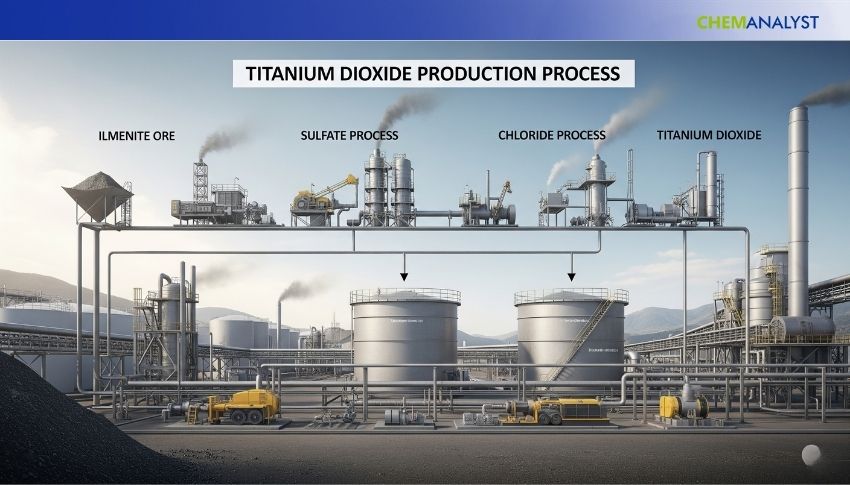Welcome To ChemAnalyst

Titanium Dioxide (TiO2) is a high-performance white pigment critical to industries such as paints, coatings, plastics, paper, cosmetics, and even food. This blog explains the journey from raw titanium ores (like ilmenite and rutile) through the sulfate and chloride processes, detailing the chemical treatments, purification steps, and final pigment formation. It also discusses the environmental considerations of TiO2 production, waste management practices, and technological advancements aimed at enhancing quality and reducing carbon footprint.
I. Introduction
Titanium dioxide (TiO2) plays an important role across many industries from giving paints and coatings their brilliant white color and hiding power to protecting plastics, cosmetics and paper from UV damage. Learning how it’s made matters because the process influences cost, environmental pollution and how quickly manufacturers can scale operations. With rising global demand expected to grow by around 6% annually making production cleaner and more efficient is essential. This blog explains the full production process in simple terms showing how manufacturers transform raw materials into TiO2, manage by-products and work toward greener methods.
II. Overview of the Production Process
There are two key methods of manufacturing Titanium dioxide: sulphate process and chloride process.
Key stages in both:
1. Raw ore digestion
2. Removal of impurities
3. Formation of a titanium compound
4. Conversion to Titanium dioxide
5. Filtering, washing, calcining and milling
Typical yields for high-grade rutile in the chloride route reach over 90%. By-products include iron sulphate or liquid iron chlorides in the sulphate route and iron chloride or small amounts of chlorine gases in the chloride route.
III. Raw Materials and Input Requirements
• Main ores: Ilmenite (FeTiO3, 40–60% Titanium dioxide rutile (up to 99% Titanium dioxide) and titanium slag (75–90% Titanium dioxide).
• Batch sulphate needs ilmenite or slag plus sulfuric acid; chloride uses high-purity rutile or slag along with coke and chlorine.
• Purity of ore matters: steel contaminants (Fe, V, Ca, Mg, radioactive isotopes) must be low for the chloride route
• Additives/catalysts: Sulphate route uses water and possibly flocculants; Chloride uses coke (carbon) and chlorine gas.
IV. Major Production Routes
1. Sulphate Process
• Ore is crushed and digested with sulfuric acid → creates titanium oxysulphate and iron sulphate.
• Iron removed by crystallization; TiOSO4 is hydrolyzed to TiO2 · H2O.
• Precipitate is washed, filtered, and calcined to produce TiO2 (anatase or rutile).
• Produces anatase or rutile versions of Titanium dioxide; yields acid waste streams, iron as by-product.
2. Chloride Process
• High-grade ore reacts with chlorine and coke at ~1000?°C → makes TiCl4 and FeCl3, CO, and CO2.
• TiCl4 is distilled to remove impurities and oxidized at ~1000?°C to form Titanium dioxide and chlorine is recovered later.
• Produces mainly rutile TiO2 with fewer waste products but needs chlorine handling and corrosion-resistant equipment.
V. Equipment and Technology Used
• Batch reactors in sulphate process: digesters, crystallisers, filters, dryers and rotary kilns.
• Continuous units in chloride process: chlorinator (fluidized bed or rotary kiln), TiCl4 distillation columns, oxidation furnaces and off-gas scrubbing systems.
• Control systems: automated flow, temperature and pressure sensors help ensure stable operations.
• Innovations: modern plants reduce energy use and control emissions better. Membrane separation and acid recycling reduce waste. Distillation columns in chloride process are improved to purify TiCl4 faster.
VI. Environmental and Safety Considerations
• Emissions: Chloride route emits CO2 (from coke) – ~1.34?t CO2 per t TiO2 produced. Sulphate produces less direct CO2 but uses more energy for calcining.
• Air pollution: Need scrubbers for sulfur dioxide (sulphate) and chlorine/hydrochloric acid (chloride).
• Wastewater and solid waste: Sulphate process generates acid streams and iron salts often recycled. Chloride produces iron chloride as by-product; chlorine is recovered later.
• Regulations: Chapman frameworks like EPA's Subpart EE mandate methane/CO2 reporting from chloride plants
• Safety: Chlorine and TiCl4 require corrosion-resistant steel, robust safety protocols, and operator training. Sulphate route uses strong acid requiring acid-resistant materials.
VII. Conclusion and Future Innovations
Research continues on greener processes such as hydrometallurgical routes, nanoscale TiO2 via green chemistry, and acid loop recycling. Chloride method may shift to lower-carbon fuels, while new catalysts can lower energy needs and work at lower temperatures. Over the next years, sustainable production, circular waste reuse and bio-based routes (e.g., plant extract crystallization) will likely become common. TiO2 will stay essential but how it’s made will evolve to be greener and more cost-effective.
From raw ore to bright white paint TiO2 is a vital chemical commodity. Each stage matters for cost, safety and the planet. By staying smart about ore quality, process choices and cleanup systems plus moving toward greener methods the TiO2 path can shine on for decades to come.
We use cookies to deliver the best possible experience on our website. To learn more, visit our Privacy Policy. By continuing to use this site or by closing this box, you consent to our use of cookies. More info.
